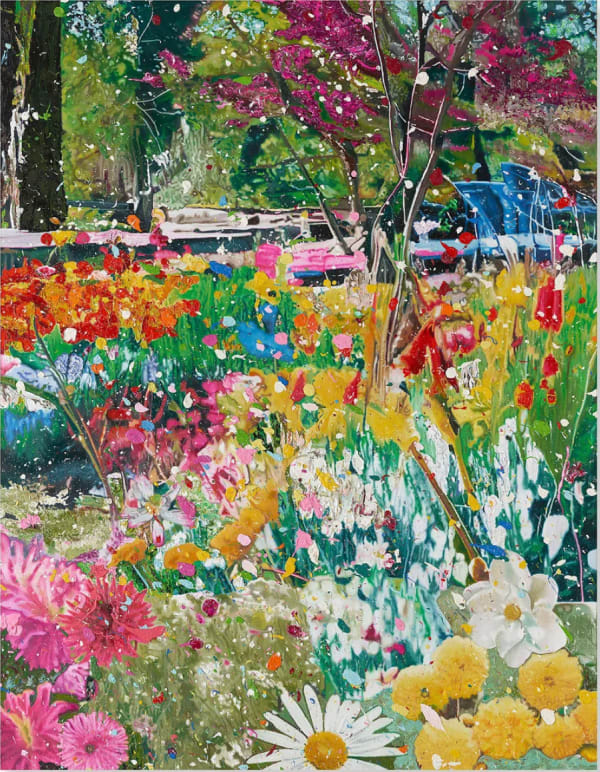-
Overview
“I believe all painting and art should be uplifting for the viewer.”
Damien Hirst, a renowned figure in the world of contemporary art, has made a significant impact with his diverse artistic expressions, including his prints, paintings, and installations. Notable for incorporating unique themes and motifs such as butterflies, spots, and pills, Hirst's works are a blend of aesthetic beauty and deep thematic exploration.
His butterfly-themed artworks, utilizing real butterflies or their wings, are a testament to his engagement with natural beauty and the themes of life's fragility and rebirth. The spot paintings, characterized by their uniform, colored spots arranged systematically, reflect Hirst's fascination with color and form, as well as his commentary on the pharmaceutical industry.
Pills and pharmaceuticals, recurrent motifs in Hirst's art, are prominent in his installations and cabinet works. These pieces often feature rows of pills or drug packaging, highlighting society's dependence on medicine and the fine line between healing and harm. Hirst's installations, such as his 'Natural History' series, confront viewers with direct representations of death and preservation, inviting reflection on the nature of existence and the human condition.
If you are captivated by Damien Hirst's unique and thought-provoking works and are interested in the aesthetic and thematic depth they offer, you might consider acquiring a piece for your collection. Owning a Damien Hirst artwork is not just an investment in a physical piece, but an engagement with profound questions and reflections his work provokes.
Conversely, if you are contemplating selling a Damien Hirst piece, you are offering someone else the opportunity to engage with these impactful themes and own a part of art history.
For inquiries, discussions, or to explore the possibilities of buying or selling Damien Hirst's artwork, feel free to reach out. Whether you're a seasoned collector, a fan of contemporary art, or new to the art world, we can assist in guiding you through the process, ensuring you find the piece that resonates with your personal taste or the perfect buyer for your valued artwork.
-
Series
-
All
-
Colour Chart
-
H1 - Enter the Infinite
-
H4 - Veil Spots
-
H5 - Colour Space Spots
-
H6 - The Aspects / Elements
-
H7 - Heart and Rainbow Butterflies
-
H8 - Fruitful / Forever
-
H9 - The Virtues
-
H10 - The Empresses
-
H11 - The Currency
-
H13 - Where the Land Meets the Sea
-
H14 - The Secrets
-
Lessons in Love
-
Love
-
Love Poems
-
Mickey / Minnie
-
Original Works - Butterflies
-
Original Works - Spin Paintings
-
Original Works - Spot Paintings
-
Psalm
-
Sanctum
-
Sculptures
-
Skulls
-
Souls
-
Spot Prints
-
The Cure
-
The Last Supper
-
The Wonder of You
-
Utopia
-
-
Exhibitions
-
News
-

Damien Hirst
Souls April 30, 2024Damien Hirst's Souls series presents a captivating exploration of life, death, and the essence of being. Departing from his earlier works, which often featured preserved...Read more -

Sotheby's: March Print Auction Top Lots
March 21, 2024Held March 20 at Sotheby's London, the Prints & Multiples sale showcased the best of contemporary and pop printmaking with stellar results for works by...Read more -

The Market and Meaning of Damien Hirst's Spot Paintings
Investment Analysis February 5, 2024In the vibrant tableau of contemporary art, few motifs have sparked as much fascination and debate as Damien Hirst's spot paintings. These works, characterized by...Read more -

Damien Hirst
Priceless Provocations: The Ten Most Expensive Damien Hirst Artworks Ever Sold at Auction December 31, 2023 Read more -

Damien Hirst
The Virtues December 31, 2023 Read more -

2023 In Review
A Look Back December 29, 2023TO WRAP UP THE YEAR, WE ARE TAKING A LOOK BACK AT OUR TOP 10 BEST SELLING ARTISTS OF THE GALLERY. ANDY WARHOL WARHOL'S ART...Read more -

Damien Hirst
Butterflies July 5, 2023'I think rather than be personal you have to find universal triggers: everyone's frightened of glass, everyone's frightened of sharks, everyone loves butterflies.' Butterflies have...Read more
-














